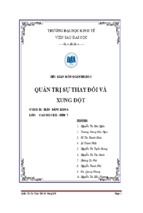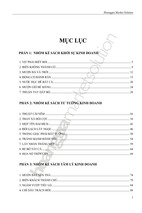Starting up
Achieving success with professional business planning
About this handbook
Contents
Authors
Thomas Kubr
Heinz Marchesi
Daniel Ilar
McKinsey & Company, Inc. The Netherlands
Amstel 344, 1017 AS Amsterdam
© 1998 by McKinsey & Company, Inc. Switzerland
Design and realization: Mifflin-Schmid, Zurich
Printed in Switzerland
ISBN 90-9011748-2
The New Venture Business Plan Competition
Preface
4
7
Acknowledgements
8
About this manual
9
Part 1: Starting up a company – how companies grow
15
Part 2: The business idea concept and presentation
Example: CityScape
29
47
Part 3: Developing the business plan
Introduction
1. Executive Summary
2. Product idea
3. Management team
4. Marketing
5. Business system and organization
6. Realization schedule
7. Risks
8. Financing
51
53
57
59
65
73
95
111
117
123
CityScape business plan
151
Part 4: Valuing a start-up and raising equity
183
Appendix
Extended table of contents
Glossary
References for further reading
215
217
223
230
3
THE NEW VENTURE BUSINESS PL AN COMPET IT ION
An incentive for setting up companies
New Venture is a business plan competition that gives students, researchers and
others in the Netherlands the opportunity to set up a company on the
basis of an innovative business idea. New Venture is an initiative of
McKinsey & Company and is organized by de Baak, Management
Centrum VNO-NCW.
New Venture is looking for ambitious new business ventures based on promising
and viable ideas. Projects of this nature require great commitment
and farsightedness on the part of their initiators, experience in
starting up companies, and — of crucial importance — access to
investors who are prepared to finance such projects. New Venture
provides participants with the ideal environment for learning, refining,
and actually setting up a promising business venture.
Three rounds
The Dutch New Venture business plan competition includes the following rounds:
Round 1: Concept and presentation of a business idea. This round focuses on how to
articulate your business idea. This is the first step towards the actual
writing of a business plan: you have to get a clear picture of what
exactly you want to deliver to which customers.
Participants of this round have to describe what problem their idea solves, what is
new about their product, why customers would want to use it, who the
target group is and who is going to pay for the product.
The jury, which mainly consists of professional venture capitalists, will provide
feedback to the participants who entered an innovative idea at the end
of the round.
Round 2: Assessing the feasibility and potential of the start-up company. This round
examines the feasibility of your idea and what need the product or
service adresses. With the help of your team coach (experienced
4
manager), and market researchers, lawyers and accountants, you will
not only estimate your idea’s chances of success, but also discover
unexpected opportunities.
In this round you have to answer the following questions: Are you able and allowed
to produce your product on the necessary scale? In what way is your
product better than its competition? Who are your competitors, and
how can they be prevented from copying your idea? What is the current
and long term market potential? What price are your customers willing
to pay for your product, and will that be enough to make a profit?
The analyses of this round will eventually end up in your business plan — if your
idea proves to have the required potential. Should your idea fail to
“pass” this feasibility test, you have at least have been prevented from
writing an entire business plan for nothing.
Entries to this round will again be judged by the jury. The participants will be provided
with feedback.
Round 3: Preparation and presentation of the business plan. A strong business plan
meets the requirements of investors in terms of both form and content.
In this round, participants again have access to their coaches, and to
a wide range of specialists that will help make the business plan a
“winner”.
Your business plan must answer all questions regarding your future enterprise an
investor might have, so it must report your product idea, the profiles and
competencies of the management team, the marketing possibilities of
your product, the way your company will operate, the detailed time
planning of the realization of your company, the risks involved and the
financial planning.
At the end of this round, there will be a presentation to the jury of the most promising
plans. There are three prizes of Dfl. 50.000 each for the best business plans.
Additional information
You can get additional information about the requirements for each round of the
competition at our web site, www.newventure.nl, and from several
kick-off and networking events at universities.
5
The New Venture Business Plan Competition offers ongoing support and a wide
range of information. In preparing your business plan, you will have
access to experienced coaches, at no cost.
How to use this book for the competition
This book was written to be used by anyone who wants to set up a high-growth
company, and it does not fully reflect the rounds of the competition in
its structure.
For round 1, participants can follow the instructions of part 2 of this book: The
business concept and its presentation. The example at the end of part
two extensively describes what is necessary for the competition;
check the New Venture website or the “deelnameset” for more information about the requirements of entries for round 1.
As round 2 in fact amounts to drafting parts of your business plan, instructions are
to be found in part 3 of this manual: Preparing the business plan.
The following sections are important:
chapter 2, Product idea, sections The irresistible business idea and Protecting your
business idea (pages 59 to 62)
chapter 4, Marketing, sections Market and competition and Choosing the target
market (pages 76 to 85)
chapter 8, Finance, section Basic accounting principles (pages 138 to 149).
For an example entry for this round, check the website.
For round 3, participants should follow part 3 of this book: Preparing the business
plan, entirely, and compose their entry accordingly.
Part 4 is intended for management teams of Start-up companies – or consultants advising them – that have prepared a business plan and are now seeking to
cover their capital requirements with funds from an outside investor.
This part describes how the value of a business can be estimated and
how venture capitalists look at the business as a potential investment.
P R E FAC E
The Netherlands has a long business tradition and has produced many great entrepreneurs. Whether Dutch-born or from other countries, they have
enjoyed an environment that enabled them to put their ideas into
practice. If we wish to remain an economic force to be reckoned with
in the future, we must continue to spawn such entrepreneurs.
In the McKinsey report, “Boosting Dutch economic performance”, the lack of
innovative start-ups was identified as one of the main obstacles for
growth. To change this situation, the government can and does play an
important role in stimulating new companies. The Ministry of
Economic Affairs has launched the “Twinning Concept”, an initiative
aimed at promoting the fast-growing Information and Communication
Technology (ICT) sector. For its part, McKinsey has followed up on its
report and taken the initiative to organize a business plan competition
to help all potential entrepreneurs start up real businesses based on
innovative ideas. Now de Baak Management Centrum VNO-NCW will
continue the organization of the competition.
If you have picked up this manual because you have a promising business idea and
you are thinking of starting up a company to realize it, then I encourage
you to seize this opportunity and participate in our competition. We wish
all those who join in New Venture an enjoyable and instructive experience and, above all, every success in the competition and, subsequently,
in business.
Robert Reibestein
Managing Partner
McKinsey & Company, Inc. The Netherlands
Have fun!
We wish all participants in the Business Plan Competition an exciting and instructive
time. The excellence of your work coupled with a bit of luck — you will
need that too — could even be rewarded with one of the prizes: a great
encouragement to pursue your promising idea.
6
Starting up
7
AC K NOW LE D G E M E N TS
This manual was originally created on the initiative of the Swiss office of McKinsey &
Company. McKinsey’s worldwide knowledge and experience of
numerous start-up projects have contributed significantly to the
content. Right from the start, however, the project has also enjoyed a
great deal of support from outside sources. Many practitioners —
experienced entrepreneurs and leading venture capitalists — have provided first-hand accounts of how successful enterprises come about,
and the points that need particular consideration when starting up a
company: Bernard Cuandet, Peter Friedli, Matthias Reinhart, Olivier
Tavel, Hans van den Berg, Branco Weiss, Brian Wood and Hans Wyss.
About this manual
Many of our colleagues from McKinsey Switzerland have contributed to this work
in one way or another, in particular Benedikt Goldkamp, Jules Grüniger,
Ralph Hauser, Ueli Looser, Felix Rübel, Bruno Schläpfer and Barbara
Staehelin. Further, we thank the Dutch New Venture team for adapting
the text to the Dutch competition and their many suggestions for
improvement.
It is our hope that this manual will prove to be a reliable and helpful tool to all
those who turn to it.
The authors
Thomas Kubr
Heinz Marchesi
Daniel Ilar
8
9
About this manual
About this manual
Victory usually
goes to those
green enough
to underestimate
the monumental
hurdles they are
facing.
Richard Feynman
Physicist
10
This manual is aimed at helping you through the first stage
of starting up an innovative, high-growth company: writing a professional business plan. Read it if you have a new business idea with
high-growth potential which you want to develop and realize. Your
goal might for example be to set up a business that, in five years’
time, has sales of around Dfl. 50 million, employs at least 100 people
and operates nationally, if not internationally.
Basically, everything you need is available in the Netherlands. There is no lack of promising innovative ideas, our research and
technology have an international reputation and financing is available
in the form of venture capital or investment funds. In short, conditions
here are almost ideal. The trick is to take advantage of these conditions
to achieve a breakthrough.
Think big
Do not hesitate to do things on a large scale. Setting up a
company is by far the largest step you’ll take: it involves a tremendous
effort. Comparatively, the extra effort required to generate Dfl. 50 million sales as opposed to, say, Dfl. 5 million, is small. Thinking big can
even make the task easier, as many potential partners are more interested in large-scale proposals than less ambitious ones.
Starting up
About this manual
11
About this manual
About this manual
FO R W H O M T H I S M A N UA L I S I N TE N D E D
The importance of a business plan
Professional investors will only back projects that have a well-prepared
This manual is aimed at anyone who wants to set up a business — particularly a
high-growth business. It takes account of the fact that people who
start up successful companies are not necessarily management or
marketing experts.
business plan. They consider business plans very important for reasons that
are relevant to anyone setting up a business.
To those with no management training this manual offers:
◆
A step-by-step introduction to the concepts needed to prepare a
business plan and arrange the financing of a business idea.
✜ Forces the people setting up the company to think their business idea
through systematically, thus making sure that it will have sufficient impact
◆
The basic knowledge needed to participate effectively in discussions
and negotiations, and ask the right questions.
✜ Reveals gaps in knowledge, and helps to fill them in an efficient and structured manner
◆
The necessary business language: all the jargon and technical
expressions you need to know are explained and used in the text.
There is also an extensive glossary in the appendix of the book.
◆
References for further reading.
The business plan
✜ Ensures that decisions are taken, so that a focused approach will be adopted
✜ Serves as a central communication tool for the various partners
✜ Lists the resources that will be needed, and thus reveals which resources
will have to be acquired
For those who have had management training, the manual offers a systematic
approach to writing a business plan.
✜ Is a dry run for the real thing. No damage is done if the likeliness of a crash
landing is revealed in the business planning phase. Later on, however, the
effects on the business, the investors and the employees of the company
might well be disastrous.
A sound business plan, therefore, is the basis on which a business idea can
be realized, and serves to obtain the capital required for setting up and
successfully developing a business.
12
Starting up
About this manual
13
About this manual
M A N UA L D E S I G N
Part 1, Starting up a company — how companies grow, describes the consecutive
stages that a typical start-up company will go through on its way to
realization and success.
Starting up a company –
how companies grow
Part 1
This manual has been conceived both as a practical working tool and as a reference
guide. This is reflected in its design, which basically matches the stages
in the preparation and writing of a professional business plan that
could successfully attract venture capital.
PA RT 1
Part 2, The business concept and its presentation, describes how business ideas
arise, what to look out for when describing a business idea, and how
to recognize whether a business idea is likely to attract financing. This
part also includes an example of what a business idea might look like.
Part 3, Preparing the business plan, is the core of the manual. It contains eight chapters: one for each of the sections a business plan should include. The
stages in the preparation of each section are set out in detail. People
without prior business experience will also find some basic business
knowledge in this part.
Business plan Cityscape. An example of a professional business plan in both form
and content.
The appendix contains a detailed table of contents, a glossary of important terms,
and references for future reading.
14
15
Starting up a company –
how companies grow
Part 1
Part 1
Many are stubborn
about the path
they have chosen,
few about the
destination.
New high-growth companies are entrepreneurial ventures
with the ambition of achieving substantial sales of, for example,
Dfl. 50 million or employing, say, 100 staff within five years of their
foundation. During this period, what began as a start-up should have
become an established enterprise. This is a significant distinction
compared to less ambitious company foundations. New high-growth
companies are rarely in a position to finance themselves; they can
only be realized with the assistance of powerful professional investors.
Thus, for anyone setting up a high-growth company, finance is the
existential issue. This means that, right from the start, the concept
must be regarded from the perspective of future investors.
In this chapter, you will find:
◆
◆
◆
The essential factors in starting up a successful company
How professional investors look at new companies
The typical process for starting up a high-growth
business.
Friedrich Nietzsche
Philosopher
16
Starting up
Starting up a company – how companies grow
17
STA RT I N G U P A S U CC E S S FU L CO M PA NY
Successful companies are set up by combining three elements.
Part 1
Part 1
3. The management team is the critical element in setting up a company. What distinguishes a good management team is discussed in full in Chapter 3, The
management team. High-growth new companies are not one-man
bands; they can usually be realized with a team of three to five entrepreneurs with complementary skills. Forming a team is well known to
be a difficult process that requires a great deal of time, energy and
sensitivity. So start on it right away, and continue working on it
throughout the entire planning process.
Business idea
TA K E T H E I N V E STO R S ’ P E R S P E C T I V E
New entreprise
10 0
100
Management
team
Capital
1. Without a business idea, there is no business. However, the idea is not the end of
the creative process, it is its beginning. Many people are so in love
with their idea that they fail to see that it is, at best, the point of
departure for a lengthy development towards a mature business idea,
and that it must withstand tough challenges before it even has any
prospects of financing and market success.
The entire start-up process must be geared toward the successful procurement of
capital. Professional investors are the toughest test of a business idea’s
chances of success. So, focus all your communication on investors;
learn to think the way they do. Even if you do not need an outside
investor, you should look at your venture from this perspective.
Investors will not be satisfied with a simple description of a business
idea — however attractive it may be. Investors want to know exactly
what they are putting their money into, and who the people behind the
project are. For them, the team is at least as important as the idea.
Investors also want to know, from the start, when their involvement will
end, and how they will get their investment back. Making a profit is
always the reason why investors want to get involved.
2. Money is essential. Luckily, adequate capital is available in The Netherlands, so
that projects that are promising from the point of view of investors will
undoubtedly find funding: the trick is to look at an idea from the
investors’ perspective.
18
Starting up
Starting up a company – how companies grow
19
T H R E E STAG E S I N T H E STA RT- U P P RO C E S S
Financing a business with venture capital
Besides financing, what do professional venture capitalists have to
offer to a new entrepreneur?
Part 1
Part 1
What is venture capital?
Venture capital is money for financing new businesses, made available
by risk- capital partnerships or individuals. Typically, venture capital is invested
in projects that offer a chance of high profit, but also involve high risk. Venture
capitalists expect a profit from their investment corresponding with the risk
involved. Accordingly, they follow a start-up project very closely to ensure that
the potential is actually realized.
The investor’s perspective is reflected in the typical start-up and development process for high-growth businesses. For an investor, each stage ends
with a milestone; for the entrepreneur with a hurdle that must be surmounted. It is important to have a clear understanding of the work
involved at each stage, and the challenges that the hurdles represent.
This will spare you not only unnecessary effort in setting up your company, but also disappointments.
Development process
✜ Coaching and motivation for the founding team
✜ Specialist knowledge in building up new businesses
✜ Access to a network of experienced entrepreneurs, potential clients, business
partners and managers who can help you make your business a success
How to choose a venture capitalist?
Development of
business idea
attention from
investors
Business
planning
Venture capitalists will also move into the driver’s seat if the management
team fails to achieve its targets.
financing
decision
Start-up and
expansion
✜ Advice on how to realize the success of the company (sale, listing of shares
on stock exchange).
realization
of gains
Established
business
Venture capitalists generally expect to take a significant share in a new
business. But they also provide powerful support, that goes far beyond their
financial involvement, and share decisive responsibility for the success of the
business. There are differences between the various venture capitalists, and
the management team should know its investors well. If you would prefer to
have 20% of a Dfl. 100 million business than 80% of a Dfl. 5 million business,
you should not only choose your investors according to who offers the most
In Stage 1 you put your business idea down on paper and analyze its marketability
on the basis of a few key indicators. The hurdle that might be facing
you as a founder at this stage is getting investors interested in the
business idea and convincing them that it is basically worth financing.
money at the best conditions.
In Stage 2 you will elaborate your business idea and turn it into a detailed business
plan. Your hurdle at this stage might be to get access to the funds
necessary to build up the business.
20
Starting up
Starting up a company – how companies grow
21
Eugene Kleiner
Venture capitalist
Part 1
Part 1
Use the planning
process to decide
if the business is
really as good as
you think.
Ask yourself if you
really want to spend
five years of your
life doing this.
Stage 3 will require the most effort on your part. Business plan in hand, you will now
have to build up a company that functions. Your goal is a successful
business. One that is profitable and provides interesting employment
for many people. When this stage is completed, it is time for the initial
investors to withdraw: the company is no longer a start-up, but an
established firm, which can be listed on the stock exchange or, alternatively, sold to another company.
If you want to be successful, this setting-up process will provide a structure for your
task as the initiator of a business idea, and for the path leading to your
own company. The investors' requirements will have a decisive effect
on how, and with what approach, you handle the various stages of
setting up your company.
Stage 1: Developing the idea
The starting point is one “bright idea” — the solution to a problem. This may be a
new product or service, but it may also be an innovation within an
existing business for example, a new production process, a new form
of distribution, or some other improvement in the design, production
or sale of a product or service. The idea must be tested to see whether
there are customers for it, and how large the market might be.
Basically, the idea itself has no intrinsic value. It only acquires economic value when it has been successfully realized in the market.
You need to start putting together a team and finding partners who will develop your
product or service until it is ready for the market (or very nearly so – in
the case of a product, this would probably be a working prototype).
During this phase you will usually have to manage without venture
capital. You will still be financing your enterprise with your own money,
with support from friends, perhaps with state research subsidies, contributions from foundations, or other resources. Investors refer to this
as “seed money”, as your idea is still a seed, not yet exposed to the
harsh climate of competition.
Your goal in this phase must be to present your business idea and your market – the
basis of your new company – so clearly and impressively that potential
22
Starting up
Starting up a company – how companies grow
23
investors would be interested in developing the idea further with you.
You will find some basic practical tips on this in Part 2 of the handbook.
During the planning phase, you will be in contact with many people outside your
founding team. Potential investors will not be satisfied with just
reading a business plan. They will usually want to participate in its
preparation before they get involved in the future company. If they are
to support, coach, and contribute their industry experience and
relationship networks, they will want to get to know the people
behind the idea: Do they tackle their tasks with confidence? Do they
demonstrate management and communication skills? Are they open
and honest? Do they have relevant experience? Last but not least, are
they able and willing to put their ideas into practice?
Apart from the investors, you will also need to talk to a large number of specialists:
lawyers, tax consultants, market researchers, advertising agencies.
You must also get in touch with your potential customers, to start
estimating the size of the market. You must find your suppliers, and
perhaps sign the first contracts. And you will want to get to know your
competitors.
24
Taking the business planning phase seriously, and doing the work conscientiously
always pays off. Ultimately, it will be the market that decides on the
value of your business idea, and its judgment will be ruthless. The
purpose of the business plan is to subject the idea to a thorough
examination prior to this ultimate test; it’s the idea’s trial run before
it faces the realities of the business world. While preparing the business plan, you and your future investor will together put all aspects
of the business through a dry run. The professional venture capitalists
will be the most rigorous judges, because they will be the most
realistic. During this phase, you will have to show that the business
can function, that the operating assumptions in the plan are realistic,
and that you and your team are in a position to make the business
successful in the marketplace. Despite every precaution, a highgrowth company remains an investment risk. Experience shows that
out of every ten venture-capital-financed businesses, on average only
one will be a huge success, three will yield adequate returns, three
will stagnate, and three will suffer total loss. So, it is understandable
that investors do everything possible to limit the risks to their
investment — on the other hand, risk is also their business.
Part 1
Part 1
Stage 2: Preparing the business plan
In this phase, it is vitally important to keep an eye on the overall picture. Don't get
lost in the details. The business plan will help you here: you must
think through and weigh up the risks in your business idea. You must
be ready for the unexpected, and learn to think in “scenarios”. You
must prepare plans and initial budgets for the most important functions of the business – for development, production, marketing, distribution and finance. And you will, of course, need to make a lot of
decisions: which customers or customer segments will you address?
What price will you ask for your product or service? What is the best
location for your business? Will you do your own production or
cooperate with third parties? And so on.
Limiting the risk
Financing expenditure with your own funds
During this intensive concept phase, you will naturally be running up
costs. The team must earn a living, a basic operation must be kept
going, and a prototype developed. However, in this phase too, you
should be able to have a good idea of the costs involved. Funds will
still have to come from the same source or sources as in the first
phase, though investors may on occasion be prepared to make an
advance.
For you as the founder of the company, this phase is successfully concluded when
investors are ready to finance your venture. You will find more about
this in Part 3 of the handbook.
Starting up
Starting up a company – how companies grow
25
Stage 3: Setting up the company, market entry and growth
The conceptual work is now largely complete, and it is time to put the business
plan into practice. From being the designer of the business, you now
become its constructor. Business success must now be sought and
achieved in the market. Typical important tasks are:
The reward for your efforts
What began as a risky venture has now become an established business. In the
course of its short life you have created a large number of jobs and
gained many customers with your innovative solution. And the effort
has also been worthwhile financially.
Part 1
Part 1
◆
◆
◆
◆
◆
◆
◆
◆
◆
Setting up the company
Building up the organization and management
Building up production
If your efforts are not crowned with success, at least you have gained some valuable experience, which will leave you better placed for a subsequent
venture.
Publicity
Market entry
Reacting to threats: competition, technological developments
Expanding production
Entering new markets
Developing new products
This phase will show whether your business idea was a good one –
and will finally be profitable.
Goal achieved: realizing your success
Realization provides proof of the success of your enterprise. If all goes well, you
will be able to sell the business with at least the profit envisaged in
the business plan. For the investor, a profitable exit has been the goal
from the start. This need not mean that you too, as entrepreneur, leave
the business. Entrepreneurs often remain in the business, though in
many cases with reduced financial involvement. This enables them to
enjoy the financial fruit of their labors.
Taking the capital out can be done in various ways. Normally, the business is sold,
for example to a competitor, a supplier or a customer, or it may be
listed on the stock exchange, by means of an Initial Public Offering
(IPO). Another possibility is that those investors who wish to get out
are bought out by the others.
26
Starting up
Starting up a company – how companies grow
27
PA RT 2
Part 1
The business idea
concept and presentation
Part 2
Part 2
Shoot for the moon.
Even if you miss it
you will land
among the stars.
Les Brown
Renowned public speaker
28
29
The business idea –
concept and presentation
Part 2
Part 2
You look at any
giant corporation,
and I mean the
biggies, and they
all started with a
guy with an idea,
doing it well.
The starting point for every single successful enterprise is
a convincing business idea. It is the first milestone in the process of
starting up a high-growth company. In order to be successful you
should consider your idea from the investor’s perspective.
This means showing, clearly and concisely, what customer benefit
your idea will deliver in which markets, and how it will produce
money. Lastly, of course, you must present your idea convincingly.
In this chapter you will find out:
◆
◆
◆
How business ideas are identified and developed
What a convincing business idea must include
How to present your business idea to investors.
The CityScape case study at the end of this chapter shows
the scope and degree of detail required in a developed business
idea, and an example of how an idea might be presented.
Irvine Robbins
Entrepreneur
30
Starting up
The business idea – concept and presentation
31
H OW TO I D E N T I F Y A B U S I N E S S I D E A …
Research has shown that most original and successful business ideas are developed
by people who already have several years of relevant experience.
It takes profound understanding of the technology involved, of customer behavior, or simply of the sector concerned to develop a
business idea to the necessary level of maturity. Gordon Moore and
Robert Royce, for example, already had several years’ experience at
Fairchild Semiconductors before they founded Intel.
Linus Pauling
Chemist
Part 2
Part 2
The best way to
have a good idea
is to have a lot
of ideas.
However, there are examples of revolutionary concepts that have been discovered
by utter novices. Steve Jobs and Steve Wozniak broke off their university studies to found Apple. Fred Smith had the idea of FedEx, the
global parcel service, while at business school.
… A N D H OW TO D E V E LO P I T
In economic terms, even a “divine spark of genius” is worth nothing, however
brilliant it may be. Usually, a lot of time needs to be invested in the
idea for it to develop into a mature business idea: time for further
development work involving various parties.
First, the idea must pass a plausibility check. This means making a rough check of
the opportunities in your market, reviewing the feasibility of the
project, and checking how innovative it is. Very quickly, you will be
confronted with a wide range of questions, and the first problems will
arise. You must overcome these step by step, by improving and
refining your product idea, and by re-checking its plausibility. Do you
have good answers to the questions? Are you showing ways to
resolve the problems? Have you improved your idea’s chances in the
marketplace? If not, keep working on it.
Discuss your idea with friends, professors, experts, potential customers: the more
broadly and thoroughly you investigate for your idea, the more clearly
you will be able to express its benefits and its market chances. Then
32
Starting up
The business idea – concept and presentation
33
you will be properly prepared for discussions with professional
investors.
Three ways to present a business idea
A young engineer has an idea for a new product, and wants to present her
“business idea” to a potential investor. She knows that she must come
straight to the point if she is to get a hearing.
Example 1: the sales approach
“I have a great idea for a new, customer-friendly payment system with enormous potential. This is what you have always wanted, and it will make you a
It may also take a long while if the idea is ahead of its time. The perfect product has
been discovered, but it cannot yet be realized, because the complementary systems or technologies have not yet been developed. An
example of this is the Internet. There were plenty of ideas for marketing goods and services, but commercial exploitation of the Internet
was long hampered by the inadequate security of the available
payment systems.
Part 2
Part 2
How long does it take to develop a business idea? That depends. Considering the
development stages we have looked at, less than a month is highly
improbable and hardly realistic. The business idea for a product or
process development, for example, is only ready to be financed when
it is concrete enough to be brought to market in the foreseeable future, and at a reasonably predictable risk. This may take years.
Investors refer to this period as the business idea’s “seed phase”; it
is usually financed with “soft money”, i.e., with funds that make no
hard and fast demands on the success of the business.
lot of money”. The investor thinks “All hot air. I've heard hundreds of “great
ideas” – boring”.
Example 2: the technological approach
“I have an idea for a computerized machine control system. The key to it is a
fully integrated SSP chip with 12 GByte RAM and direct governing of the control unit via asymmetric XXP technology; it's taken five years to develop”. The
investor thinks “Computer nerd; in love with the technology. She's her own
market”.
Example 3: the entrepreneurial approach
“I have an idea that offers a business with up to 100 staff cost savings of
3–5%. Initial cost/price analyses have convinced me that there is a potential
margin of 40–60%. With the Small Businesses Association and ABC magazine, I have access to a focused publicity channel. Distribution would be via
direct sales”. The investor thinks “Ah; she knows what the customer benefit
is, and has even quantified it. She's also thought about the market and the
potential profit, and she knows how she intends to get the product to the
customer. Now I should really like to know what sort of a product it is”.
34
Starting up
The business idea – concept and presentation
35
Innovative business ideas
Business ideas can be positioned according to two dimensions. The first dimension
is the product/service the idea contains; the second is the way the
product/service is developed, manufactured and marketed, referred
to as “business system”. In both dimensions, it is possible to further
develop what already exists, or to develop something entirely new.
You will find more on business systems in chapter 5 of part 3, Business
system and organization.
Business innovation
Innovative
Existing industry
Existing
Product/service
New industry
Apple, Microsoft, Sun etc.
Mistral
Vacuvin
Logitech
• Trades
• Medical practices, law firms
engineering offices
• Direct satellite TV
• Netscape
New business system
• Dell
• Charles Schwab
• FedEx
Existing
When developing new products, the emphasis must be on improving “customer
benefit”. The point of innovations in the business system is above all
to reduce costs. This benefit can then be passed on, at least in part, to
the customer, as a price reduction.
Occasionally, it is possible to combine both dimensions of innovation — product and
business system. This means inventing a new “industry”. Netscape
made an essential contribution to the success of the World Wide Web
when it made its new browser available at no cost via the Internet—
Netscape makes its money by selling software to commercial customers and space for advertisers on its home page. Satellite TV offers an
almost unlimited selection of programs, sidelining traditional program
distributors, like cable or broadcasting companies, by operating its
own satellites and by selling the necessary receivers through
traditional consumer outlets.
Part 2
Part 2
New product
•
•
•
•
High-growth
start-ups
Innovations in the business system are less obvious, but every bit as important.
Dell's success was due to its significantly lower costs made possible
by a new type of production and direct distribution system: computers
were produced very quickly but only after they had been ordered.
FedEx used central sorting and 24-hour operation to revolutionize
letter delivery.
Innovative
New Business system
The concept of innovation is usually applied to new products or services that use
conventional production methods and are distributed to customers
using conventional distribution channels. Microsoft, for instance,
developed the new DOS operating system, yet used IBM’s
existing sales organization to market it. Mistral used existing sports
shops to distribute its surfboards. Bernd Schneider’s Vacuvin can be
bought in any shop for household goods.
36
Starting up
The business idea – concept and presentation
37
CO N TE N T O F A CO N V I N C I N G B U S I N E S S I D E A
The business idea has to appeal to an investor. It is neither an advertising leaflet for
a supposedly amazing product, nor a technical description, but
rather a decision-making document, which answers the following
three questions:
Karl Popper
Philosopher
38
Part 2
Part 2
If you can’t say it
simply and clearly,
keep quiet,
and keep working
on it till you can.
What is the customer benefit; or, what problem does the idea solve? Market success
comes from satisfied customers, not from amazing products.
Customers buy a product because they want a need satisfied or a
problem solved — be it by eating and drinking, reducing effort, increasing pleasure, enhancing their image, etc. So, the first characteristic of
a successful business idea is that it clearly states what need it will
satisfy, and in what form (product or service). The distinctiveness of
the product is often referred to by marketing specialists as its “Unique
Selling Proposition”.
What is the market? A business idea only has real economic value if people want the
product or service. So, the second characteristic of a successful
business idea is that it demonstrates the existence of a market for the
product or service, and identifies the target customer group(s).
How will it make money? Most products make money directly, from sales to
customers. In some cases, however, the “revenue mechanism” can be
more complicated: for example, the product is given away for free to
the consumer, and paid for by advertisers. So, the third characteristic
of a successful business idea is that it makes clear how money will be
made, and how much.
Starting up
The business idea – concept and presentation
39
- Xem thêm -





















